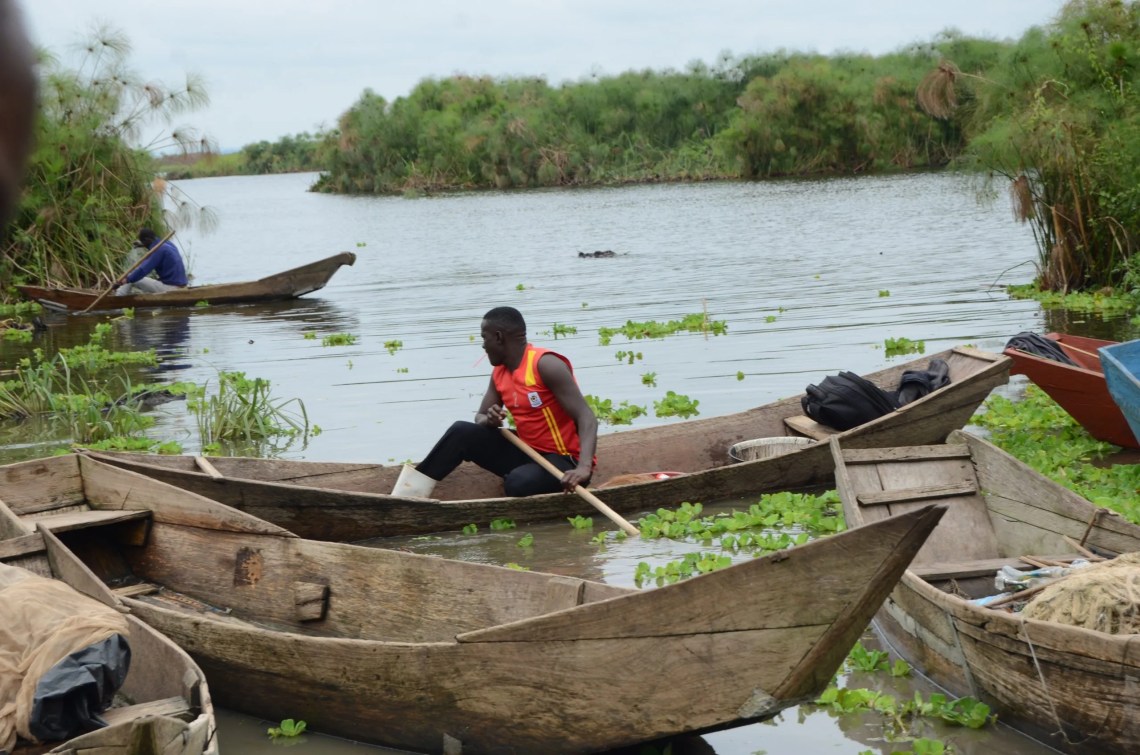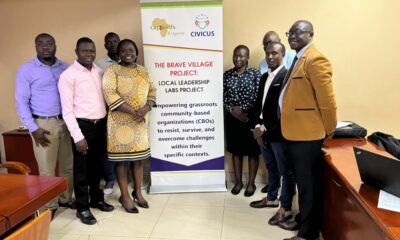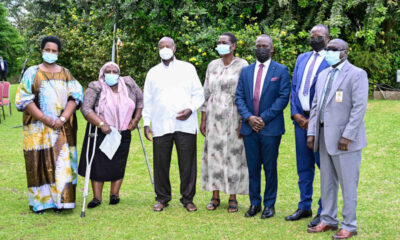News
Encroachers destroy breeding grounds on Lake Wamala
 Nnalongo Nsubuga is a worried woman. A farmer in Kyakatebe Village, Nalutuntu Sub County, Kassanda District about 120km southwest of the capital Kampala, Nnalongo Nsubuga has over the past three decades watched as her community’s agricultural productivity declines, mostly due to shifting rainfall patterns.
Nnalongo Nsubuga is a worried woman. A farmer in Kyakatebe Village, Nalutuntu Sub County, Kassanda District about 120km southwest of the capital Kampala, Nnalongo Nsubuga has over the past three decades watched as her community’s agricultural productivity declines, mostly due to shifting rainfall patterns.
She attributes this to a strong desire by charcoal producers in the area to cash in on the soaring demand for charcoal for cooking, explaining that this is resulting in environmental degradation on a large scale, threatening the health of both human and natural communities.
When we visited the area, we observed that the pressure is so intense on forests that food-providing fruit trees on private lands are being bought, cut down, and burned to make the polluting wood-sourced fuel.
According to a 2016-2017 Uganda National Household Survey summary, the country’s reliance on forest-produced fuels, including charcoal and dry wood, is huge, with 90% of households relying on various wood fuels for cooking. In urban areas, household charcoal use jumped 12.4% between 2012-13 and 2016-17. That consumption pattern — as urban charcoal use puts pressure on rural forests — is thought to be continuing today, according to the Uganda Bureau of Statistics.
This soaring call for charcoal has led charcoal makers, many of them operating without government-required licenses, and dealers to devour forests at a fast clip to keep pace with the lucrative business.
“Because of forest degradation, now they have to buy fruit trees of neighbors who want to meet their household needs. They pay them and cut the trees, like jackfruits, mangos, and avocados,” she says. They then burn the fruit trees to make charcoal.
In a matter of minutes, a longstanding source of nutritious food is toppled and lost, with the wood made into briquettes and sold — threatening the rural community’s future food security and denying wildlife arboreal fruits.
This steady and staggering loss of natural resources isn’t just a problem in Kasanda district. The situation is the same for farmers in the three other districts sharing Lake Wamala including Mityana, Mubende, and Gomba, confirmed Yasiin Bbira, the Mityana district natural resources officer citing massive encroachment on wetlands surrounding the lake.
Lake Wamala is of significant economic and cultural interest locally and is jointly administered by the districts of three districts, each of which shares a part of the lake along common borders.
Bbira told journalists that the Mityana district is experiencing massive biodiversity loss caused by a number of factors but cited a rapidly increasing population that he says is putting much pressure on the available natural resources including forests, wetlands, and Lake Wamala.
“As you move around the district, the communities can tell you that there some species of plants and animals which are now very rare,” Mr. Bbira said.
Bbira identifies Kalangaalo and Bulera sub-counties, Mityana municipality, and Busunju town council as the most affected when it comes to wetland encroachment.
Being a rural district, the cultivation of crops like beans, maize, sweet potatoes, sugar cane, grazing, and eucalyptus tree planting among others are the major threat to wetlands.
Bbira, however, says Mityana district natural resources department faces various challenges which affect its operations.
Curiously, the demand for agricultural land and agricultural systems contribute almost one-third of this loss, according to Bbira.
“There’s too much pressure on the [natural] resources especially the wetlands and the lake [Wamala]. Our population [in Mityana] is increasing by the day and there’s nothing we can do about it. Some of these people encroaching on these resources especially the wetlands and lake are foreigners. They don’t care and they think they are powerful,” Bbira explained in a detailed Q&A with reporters.
Bbira’s account was also collaborated by Mityana district production officer Daniel Sseremba who said that the number of boats on Lake Wamala is over 600 instead of the acceptable 250 boats.
In most of the highly populated areas including the coastal wetland zones of Lake Wamala which is experiencing a noticeable loss of its resources and ecological services, farmers no longer have the luxury of allowing part of their land to rest and become fertile again. They end up working the same plot year in year out.
“They cut food trees for charcoal, encroach on reserve land such as forests and cultivate wetlands up to river banks,” Sseremba said
Others, especially the youth, he said are migrating to the budding urban areas including Mubende and Mityana municipalities where they create a workforce of unskilled labor and contribute to the growth of slums.
Bbira also informed reporters during an interview at his office in Mityana Municipality that central forest reserves like Bulonda in Busimbi sub-county which surrounded the lake are gone and its wetlands and buffer zone of about 200 metres where the fish breed have also been degraded.
“This land degradation has, in turn, caused soil erosion. Whenever it rains, the silt enters the lake and when it accumulates, it pushes the lake farther inside. It pushes the shoreline, making the lake shrink.”
Bbira says Lake Wamala is losing its once rich plant and animal life which conservationists refer to as biodiversity.
“The wetland inventory last done in the early 2000s showed the species richness around Lake Wamala,” he says, “Although we have not updated that inventory, it is evident that some biodiversity has been lost for good.”
He says hippopotamus and other animal and plant species which used to call the lake and forest reserves home are gone.
Conservationists say the lake could dry up due to these piling pressures. It will not be the first time the lake has shrunk or even disappeared. In the 1990s Lake Wamala dried up and almost disappeared. People even parceled up plots and started cultivating in the middle of the lake zone.
Some of the residents we interviewed said it is not their wish to encroach on the buffer zones of Lake Wamala but they are forced by circumstances.
Mr. Emmanuel Jjuuko Kamya, a tomato grower Katiko landing site says that he can only get food to feed his family by cultivating near the lake where he finds free and fertile land.
He says the little piece of land he has is insufficient to host his house and a garden for cultivating food.
Lake Wamala becoming a dead lake
Information released by the Nation Wetlands Atlas volume two shows that the lake occupied 164 square kilometers in 1990, which reduced to 87 square kilometers by 2000. The lake could have been reduced to less than 80 square kilometres and reduced in its depth due to silting.
Lake Wamala is dotted by many islands, including Lwanju Island, Mabo Island, and Bagwe Island, Kiraza, Kazinga, among others.
Several rivers flow into the lake, including the River Nyanzi, the River Kitenga, the River Kaabasuma, the River Mpamujugu, and the River Bbimbye. The lake is drained by the Kibimba River into the Katonga River, which in turn drains into Lake Victoria. The Kibimba River, however, has now been made highly seasonal and for much of the time, its course remains essentially dry due to human actions including agricultural activities.
On a guided visit to a number of landing sites, we noted massive cultivation on the buffer zone of Lake Wamala, which is blessed with floating vegetation and several rare birds species.
Large eucalyptus plantations, tomato gardens, and rice farms are common around the lake. There is little or no deliberate attempt by the responsible authorities both at the local and national levels to protect the lake from encroachment.
Steven Nsibambi, a fisherman at Katiko landing site, says most of those encroaching on the lake has the backing of big shots in the district.
Nsibambi who has been fishing on Lake Wamala for the past two decades says fish stock in the lake has dwindled over the past years and some rare spices are extinct.
According to the Uganda National Bureau of Statistics, the fish catch from Lake Wamala reduced from 5,600 tons to 4,590 tons between 2010 and 2014.
A one Raster Man also a fisherman at the lake attributes the low fish catch to human activity around the lake involving the use of dangerous substances like pesticides, which affects the water quality and threatens the livelihood of fishermen.
“This is our lake and we want it to continue benefiting us, our children, and grandchildren,” he said.
He says that more farmers have also descended onto the lake’s buffer zones to grow tomatoes, which need a lot of water for irrigation but also pesticides that wash off into the lake whenever it rains.
“The pesticides are not good for the fish,” he says.
Naturally, the ongoing decline in freshwater biodiversity impacts the livelihoods of the rural poor in the basin, and many are worried.
He also blames the fishermen who are not only increasing in number but also increasingly using bad fishing methods which indiscriminately capture young fish.
Faced with the urgency to reverse the damages by nature by human activities, Nsibambi suggests that government needs to think of alternative livelihood projects such as poultry projects that can drive the fishermen to allow several species to regenerate.
According to the World Wide Fund for nature Uganda Country Office (WWF-UCO) report, some of the effects of climate change such as floods, droughts, and recession of water bodies have already been seen in Uganda. The report faults rural communities, smallholder farmers, and pastoralists for the highest negative impact on biodiversity across Uganda.
The study also indicated that frontier land-use change through continuously converting land for agriculture and harvesting wood for energy is propelled by population growth and poor land use and natural resource management.
“Commercial farming at industrial scale (e.g. tea and sugar) has a very direct negative and high impact on biodiversity in Key Biodiversity Areas,” the report indicated suggesting that voluntary commitments from these stakeholders to stop and reverse their negative impact on biodiversity will be challenging and will require the long-term commitment of the government of Uganda in terms of engagement and financial resources.
The also indicated that the observed loss of biodiversity in protected areas by the same drivers shows that enforcement of existing policies is equally important and within the domain of the government of Uganda.
WWF-UCO Executive Director David Duli says that while the Government of Uganda has developed various policies to support the integration of environmental and biodiversity issues into the national development plans and programs, many of these are lacking in terms of analysis of the magnitude of the contribution of key sectors.
“Although the above policies and studies are impressive in terms of strategies to tackle biodiversity loss, analysis in terms of the magnitude of the contribution of key sectors in actual terms is not addressed,” he noted.
Comments



















